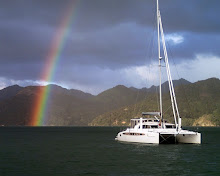





Our Banderas Bay Regatta began with moving from the marina in La Cruz 5 miles down the bay to be closer to the center of the action in Nuevo Vallarta. The “Sirocco” race team had secured a slip in the Paradise Village Marina and rented a nearby condo to help house guest crew from the States and provide a gathering place for crew relaxation and meals between events. With Paradise Village filled to capacity, we moored in nearby Marina Nuevo Vallarta which was just a short dinghy ride across the estuary. On our first night there, our group took two dinghies up the estuary, passing many signs
warning that it was a “crocodile zone”, to the Fahita Republic Restaurant for a wonderful meal. We were introduced to James and Patti who had flown from California to help out as crew. The next day, we helped with removing hundreds of pounds of cruising gear and supplies from “Sirocco” so as to make her more race-ready. While the guys shuttled loads of gear to the condo for temporary storage, the ladies made a shopping run to Costco and returned with a week’s worth of food and drink for the 11 person race crew. The day before the races were to start, we sailed out for a few hours of practice and Anne and I were quickly impressed by the boat’s performance and the talents of the crew that have raced together many time before. Mark was assigned the position of mainsail trimmer and Anne that of “sewer rat” or, more politically correct, “squirrel”. While Mark adjusted the tension and angle of the boat’s main sail with each change in course, Anne scampered about as movable ballast and took her position below deck each time a spinnaker (large, light-weight sail) was hosted or dropped. Dousing a spinnaker involves a coordinated effort and the “squirrel” pulls in the sail’s fabric from below deck as quickly as possible like an animal socking-away seeds for the winter. Crew member James, just 17 years old and already a sailing prodigy, moved quickly around “Sirocco’s” cockpit tweaking this and that to maximize the boat’s performance and giving Mark tips as to getting the most power from the main sail. The day concluded with laughter, story telling and a delicious BBQ at the condo.
The regatta consisted of 3 days of racing and race one went well for “Sirocco” as we finished in 2nd place in the class containing the fastest boats. All aboard were pleased and the group shared a warm evening together back at the condo.
The next morning began with news via the internet of Japan’s terrible earthquake and a possible tsumani being forecast for our area. A short while later, word came in via our VHF radio that tidal surge in our area could reach 6 feet in height. This started a scramble by boaters to put out to sea where deeper water would offer protection. The matter became even more surreal when word began coming in that the Banderas Bay port captains had closed all of the harbors to both inbound and outbound traffic. As incredulous as it sounded, we were being told that we faced as much as a $5,000 fine if we violated the closure orders. Before long though, the order was clarified to apply only to commercial vessels and the mass exodus began. Within an hour, the bay was filled with about 150 boats sailing back and forth while monitoring their radios for news of the tsunami’s affects. We were relieved to hear that even though the harbors were experiencing rapid and reversing changes in water depth and significant currents in the narrow entrances, most of the marinas were fairing well. An exception was in the marina in La Cruz where a large section of floating, concrete dock was swept away from it’s supporting pilings. Fortunately, no boats were attached to it at the time. To everyone’s surprise, the surges continued all afternoon and into the evening. By sunset we chose to anchor safely offshore (with about 150 other boats) as the currents in the harbor entrances were still considered treacherous. As darkness fell, we found ourselves amidst a galaxy of boats’ anchor lights enjoying the last of the day’s warm, northwesterly breezes.
With swell conditions much improved the next morning, we returned to our slip in the marina and compared notes with the few boaters that had, for whatever reason, remained in port. All felt fortunate that the tsumani had not delivered the full punch that was forecast.
Race two of the regatta was scheduled the day of the tsumani so organizers canceled it and concluded the event the following day. Our crew put in a good effort but fell short of our first race performance. After the race, the team made trip after trip between the condo and the boat returning and reinstalling the many items that had be off-loaded for the race. Before long, “Sirocco” was back in full “cruising mode”. We would later learn though that we had placed third in the regatta’s final results, quite respectable for a boat equipped for cruising.
The next day, we returned to the marina in La Cruz where we would leave “Blue Rodeo” for a few days while we flew home to visit family, do our taxes and have dental and dermatologist check-ups. The short, 5 mile run back to La Cruz was made more interesting as we towed another vessel with engine starter problems. Our friends Howard and Lynn were unable to leave the marina the day the tsunami was forecast when, at the last minute, their engine failed to start. With a little synchronized maneuvering in the harbor, we were able to pass them a towing line and help them across the bay where mechanical assistance could more easily be found. Fortunately, the sea conditions were flat with light winds and their boat, “Swift Current”, tracked effortlessly behind ours as we made the crossing.









